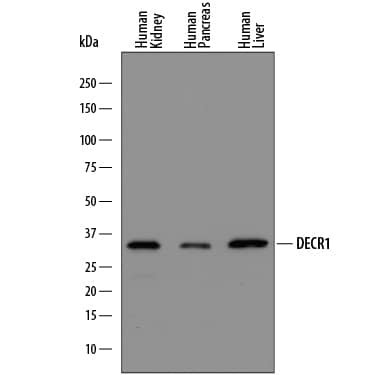Human DECR1 Antibody
R&D Systems, part of Bio-Techne | Catalog # AF7976

Key Product Details
Species Reactivity
Applications
Label
Antibody Source
Product Specifications
Immunogen
Met233-Ser335
Accession # Q16698
Specificity
Clonality
Host
Isotype
Scientific Data Images for Human DECR1 Antibody
Detection of Human DECR1 by Western Blot.
Western blot shows lysates of human kidney tissue, human pancreas tissue, and human liver tissue. PVDF membrane was probed with 0.25 µg/mL of Sheep Anti-Human/Mouse/Rat DECR1 Antigen Affinity-purified Polyclonal Antibody (Catalog # AF7976) followed by HRP-conjugated Anti-Sheep IgG Secondary Antibody (Catalog # HAF016). A specific band was detected for DECR1 at approximately 34 kDa (as indicated). This experiment was conducted under reducing conditions and using Immunoblot Buffer Group 1.Applications for Human DECR1 Antibody
Western Blot
Sample: Human kidney tissue, human pancreas tissue, and human liver tissue
Formulation, Preparation, and Storage
Purification
Reconstitution
Formulation
Shipping
Stability & Storage
- 12 months from date of receipt, -20 to -70 °C as supplied.
- 1 month, 2 to 8 °C under sterile conditions after reconstitution.
- 6 months, -20 to -70 °C under sterile conditions after reconstitution.
Background: DECR1
DECR-1 (2, 4-DiEnol CoA Reductase, mitochondrial) is a 33-36 kDa member of the DECR subfamily, short-chain dehydrogenase/reductase family of molecules. It is a mitochondrial enzyme that is expressed in multiple cell types, particularly those involved in oxidative degradation of fatty acids. Fatty acids provide energy following their degradation by four enzymes that comprise the beta-oxidation cycle. The optimal configuration for fatty acids in this cycle is one of saturation. However, many fatty acids that appear before this cycle are unsaturated, and it is necessary to transform them into a suitable configuration for processing. DECR-1 converts a two double-bonded substrate into a one double-bonded substrate, which subsequently undergoes isomerization and entry into the beta-oxidation cycle. Human DECR-1 is 335 amino acids (aa) in length. It contains a mitochondrial targeting sequence (aa 1-34), and a 301 aa mature region that possesses one catalytic site (aa 57-302). There are two potential acetylation sites at Lys110 and Lys230. DECR-1 forms homotetramers. One potential isoform variant shows an alternative start site at Met93 coupled to a deletion of aa 292-335. Over aa 233-335, human DECR-1 shares 87% aa sequence identity with mouse DECR-1.
Long Name
Alternate Names
Gene Symbol
UniProt
Additional DECR1 Products
Product Documents for Human DECR1 Antibody
Product Specific Notices for Human DECR1 Antibody
For research use only
